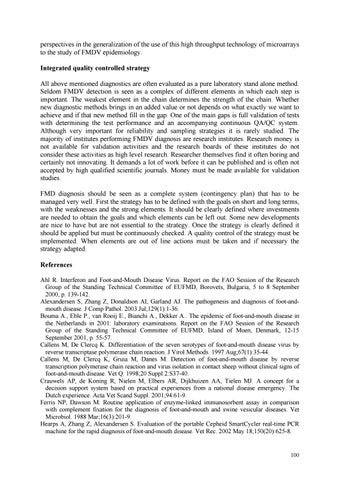perspectives in the generalization of the use of this high throughput technology of microarrays to the study of FMDV epidemiology. Integrated quality controlled strategy All above mentioned diagnostics are often evaluated as a pure laboratory stand alone method. Seldom FMDV detection is seen as a complex of different elements in which each step is important. The weakest element in the chain determines the strength of the chain. Whether new diagnostic methods brings in an added value or not depends on what exactly we want to achieve and if that new method fill in the gap. One of the main gaps is full validation of tests with determining the test performance and an accompanying continuous QA/QC system. Although very important for reliability and sampling strategies it is rarely studied. The majority of institutes performing FMDV diagnosis are research institutes. Research money is not available for validation activities and the research boards of these institutes do not consider these activities as high level research. Researcher themselves find it often boring and certainly not innovating. It demands a lot of work before it can be published and is often not accepted by high qualified scientific journals. Money must be made available for validation studies. FMD diagnosis should be seen as a complete system (contingency plan) that has to be managed very well. First the strategy has to be defined with the goals on short and long terms, with the weaknesses and the strong elements. It should be clearly defined where investments are needed to obtain the goals and which elements can be left out. Some new developments are nice to have but are not essential to the strategy. Once the strategy is clearly defined it should be applied but must be continuously checked. A quality control of the strategy must be implemented. When elements are out of line actions must be taken and if necessary the strategy adapted. References Ahl R. Interferon and Foot-and-Mouth Disease Virus. Report on the FAO Session of the Research Group of the Standing Technical Committee of EUFMD, Borovets, Bulgaria, 5 to 8 September 2000, p. 139-142. Alexandersen S, Zhang Z, Donaldson AI, Garland AJ. The pathogenesis and diagnosis of foot-andmouth disease. J Comp Pathol. 2003 Jul;129(1):1-36. Bouma A., Eble P., van Rooij E., Bianchi A., Dekker A.. The epidemic of foot-and-mouth disease in the Netherlands in 2001: laboratory examinations. Report on the FAO Session of the Research Group of the Standing Technical Committee of EUFMD, Island of Moen, Denmark, 12-15 September 2001, p. 55-57. Callens M, De Clercq K. Differentiation of the seven serotypes of foot-and-mouth disease virus by reverse transcriptase polymerase chain reaction. J Virol Methods. 1997 Aug;67(1):35-44. Callens M, De Clercq K, Gruia M, Danes M. Detection of foot-and-mouth disease by reverse transcription polymerase chain reaction and virus isolation in contact sheep without clinical signs of foot-and-mouth disease. Vet Q. 1998;20 Suppl 2:S37-40. Crauwels AP, de Koning R, Nielen M, Elbers AR, Dijkhuizen AA, Tielen MJ. A concept for a decision support system based on practical experiences from a national disease emergency. The Dutch experience. Acta Vet Scand Suppl. 2001;94:61-9. Ferris NP, Dawson M. Routine application of enzyme-linked immunosorbent assay in comparison with complement fixation for the diagnosis of foot-and-mouth and swine vesicular diseases. Vet Microbiol. 1988 Mar;16(3):201-9. Hearps A, Zhang Z, Alexandersen S. Evaluation of the portable Cepheid SmartCycler real-time PCR machine for the rapid diagnosis of foot-and-mouth disease. Vet Rec. 2002 May 18;150(20):625-8.
100
